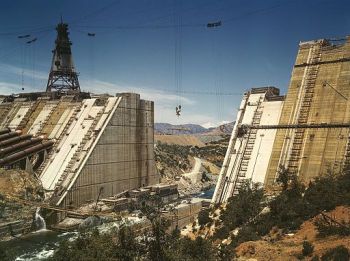Permitting

|
| Construction of the Shasta Dam in California. |
Permits help ensure that work being performed on a project is carried out in a manner that is safe and meets all applicable design codes. As the potential human and financial consequences associated with a failure at a dam are tremendous, permits help to establish legal liability and ensure the safety of the general public.
"Statutory restrictions exist with respect to control of the waters of navigable streams. Plans for diversion or control of waters in such streams are subject to approval by the U.S. Army Corps of Engineers. There are numerous other Federal and State regulations relating to dam construction and operation that may be determining factors in the design process. Every State has laws and regulations governing the design, construction, and operation of all dams and reservoirs. Engineers need to be aware that Federal, State, and regional legal requirements must be satisfied as part of the planning, design, construction, and operation process. Complying with these requirements may affect the design process."[1]
"Heads of Federal agencies are responsible for the development and implementation of policy, resources and procedures for safe design, construction, operation, and inspection of each dam under their jurisdiction, as applicable to the agency mission. The agency management structure assists the head of the agency in discharging this responsibility and shares in it. The management structure is ultimately responsible for obtaining compliance with the intent of these management and technical activities guidelines, and for assuring that procedures are evaluated and updated periodically."[2]
Best Practices Resources
![]() U.S. Army Corps of Engineers Regulations and Guidance Webpage
U.S. Army Corps of Engineers Regulations and Guidance Webpage
![]() Federal Guidelines for Dam Safety, FEMA, 2004
Federal Guidelines for Dam Safety, FEMA, 2004
Citations:
Revision ID: 5173
Revision Date: 12/12/2022
